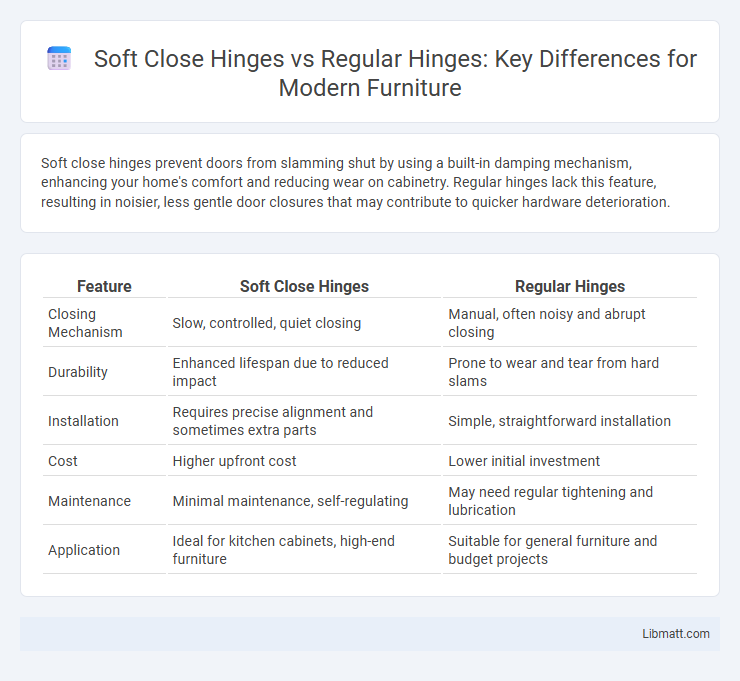Soft close hinges prevent doors from slamming shut by using a built-in damping mechanism, enhancing your home's comfort and reducing wear on cabinetry. Regular hinges lack this feature, resulting in noisier, less gentle door closures that may contribute to quicker hardware deterioration.
Table of Comparison
| Feature | Soft Close Hinges | Regular Hinges |
|---|---|---|
| Closing Mechanism | Slow, controlled, quiet closing | Manual, often noisy and abrupt closing |
| Durability | Enhanced lifespan due to reduced impact | Prone to wear and tear from hard slams |
| Installation | Requires precise alignment and sometimes extra parts | Simple, straightforward installation |
| Cost | Higher upfront cost | Lower initial investment |
| Maintenance | Minimal maintenance, self-regulating | May need regular tightening and lubrication |
| Application | Ideal for kitchen cabinets, high-end furniture | Suitable for general furniture and budget projects |
Introduction to Cabinet Hinges
Cabinet hinges are essential hardware components that enable doors to open and close smoothly while providing support and stability. Soft close hinges feature integrated damping mechanisms that prevent doors from slamming shut, reducing noise and protecting cabinetry from damage. You can enhance your kitchen or furniture by choosing between soft close and regular hinges based on your preference for noise control and durability.
What Are Soft Close Hinges?
Soft close hinges are specialized hardware designed to close doors and cabinets slowly and quietly, preventing slamming and reducing wear over time. Unlike regular hinges, they incorporate a built-in damping mechanism that absorbs impact, ensuring smooth and gentle closure. If you're looking to enhance your furniture's durability and create a quieter environment, soft close hinges are a practical upgrade from traditional options.
What Are Regular Hinges?
Regular hinges, also known as standard or butt hinges, are simple mechanical devices that allow doors or cabinets to pivot open and closed without any damping or slowing mechanism. These hinges typically consist of two metal plates joined by a pin, offering durability and straightforward installation but lack the smooth, controlled closing feature found in soft close hinges. Understanding the basic functionality of regular hinges helps you choose the right hardware based on your preference for door operation and noise reduction.
Key Differences Between Soft Close and Regular Hinges
Soft close hinges feature a built-in damper that slows the door's movement, preventing slamming and reducing noise, unlike regular hinges which lack this cushioning mechanism. Soft close hinges extend the lifespan of your cabinets by minimizing wear and tear through controlled closing, while regular hinges do not provide this protection. You'll notice smoother, quieter operation with soft close hinges, making them ideal for enhancing the functionality and comfort of your cabinetry.
Pros and Cons of Soft Close Hinges
Soft close hinges prevent doors from slamming shut, reducing noise and minimizing wear on cabinets, which extends their lifespan. They enhance your kitchen experience by providing smooth, controlled closing but come with a higher price point and more complex installation compared to regular hinges. Regular hinges are generally more affordable and simpler to install but lack the cushioning mechanism that protects your cabinetry over time.
Pros and Cons of Regular Hinges
Regular hinges offer affordability and straightforward installation, making them a popular choice for budget-conscious projects. They lack the damping mechanism found in soft close hinges, which means doors close quickly and can potentially slam, causing noise and wear over time. Maintenance is minimal, but the absence of a soft-closing feature may reduce long-term protection for cabinet frames and hardware.
Installation Process Comparison
Soft close hinges require precise alignment during installation to ensure smooth, controlled closing, often involving adjustable screws for fine-tuning. Regular hinges have a straightforward mounting process with fewer adjustment features, making them quicker to install but lacking enhanced closing functionality. Your choice will affect installation complexity and the time needed for setup, with soft close hinges demanding more attention for optimal performance.
Cost Comparison: Soft Close vs Regular Hinges
Soft close hinges typically cost between $10 to $25 per pair, reflecting their advanced damping technology, whereas regular hinges are more affordable, ranging from $2 to $7 per pair, making them a budget-friendly option. Despite the higher upfront cost, soft close hinges reduce wear and tear on cabinets and prevent slamming noise, potentially lowering long-term maintenance expenses. Choosing between soft close and regular hinges involves balancing initial investment against durability and user experience benefits.
Maintenance and Durability
Soft close hinges reduce wear and tear by controlling the door's closing speed, which minimizes impact and prolongs hinge lifespan compared to regular hinges. Maintenance for soft close hinges often involves occasional lubrication and adjustment to maintain smooth operation, while regular hinges may require more frequent oiling and tightening due to louder, more forceful closures. Durability is enhanced in soft close hinges because the dampening mechanism prevents damage to both the hinge and the cabinet, making them a longer-lasting choice for high-traffic areas.
Which Hinge is Right for Your Cabinets?
Soft close hinges prevent cabinet doors from slamming shut, reducing noise and extending the life of your cabinetry through gentle, controlled closing. Regular hinges offer a simple, cost-effective option but may lead to wear and tear over time due to abrupt closing impacts. Choosing between soft close and regular hinges depends on your preference for long-term durability and quieter operation versus initial cost savings.
Soft Close Hinges vs Regular Hinges Infographic

 libmatt.com
libmatt.com